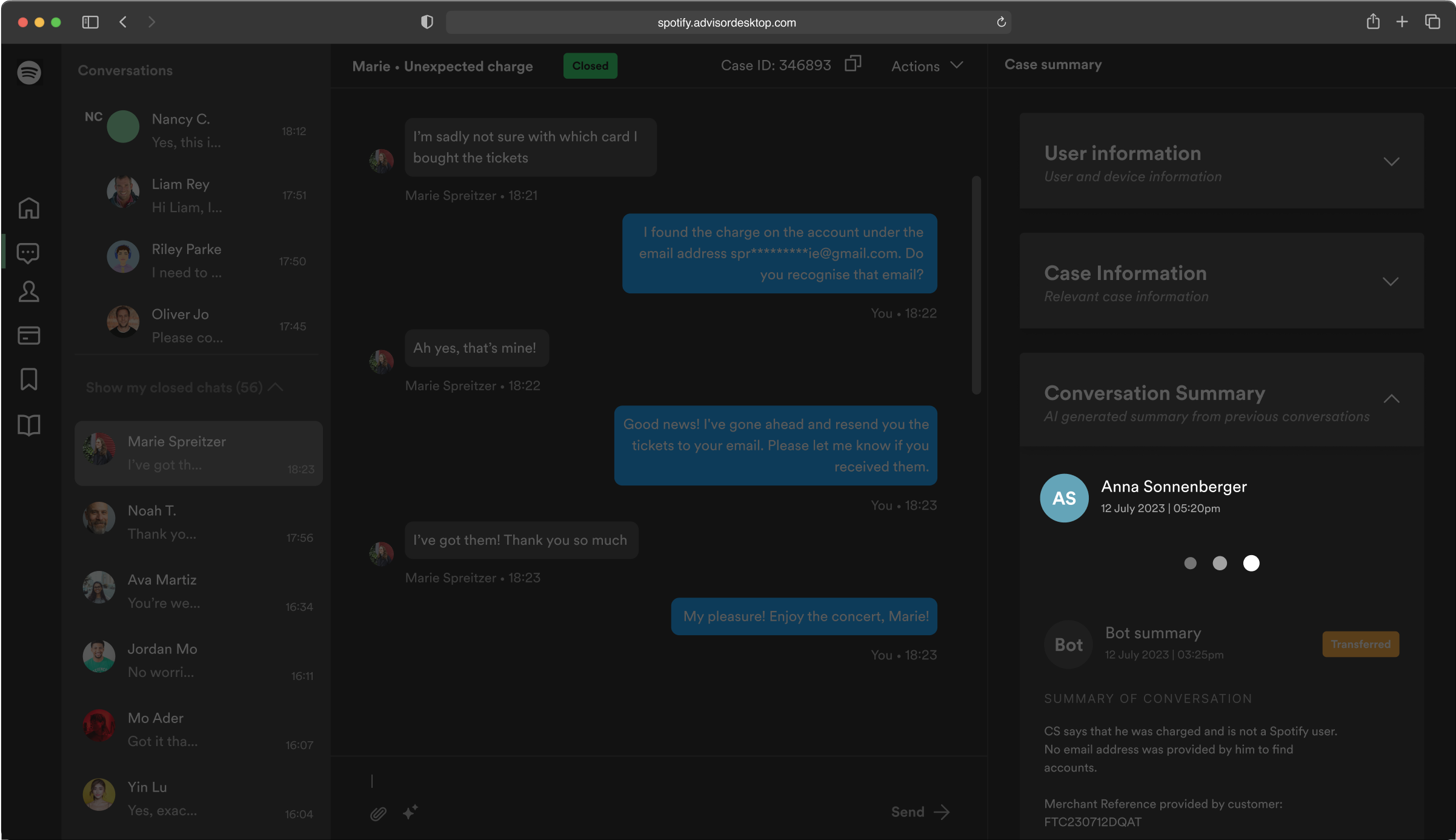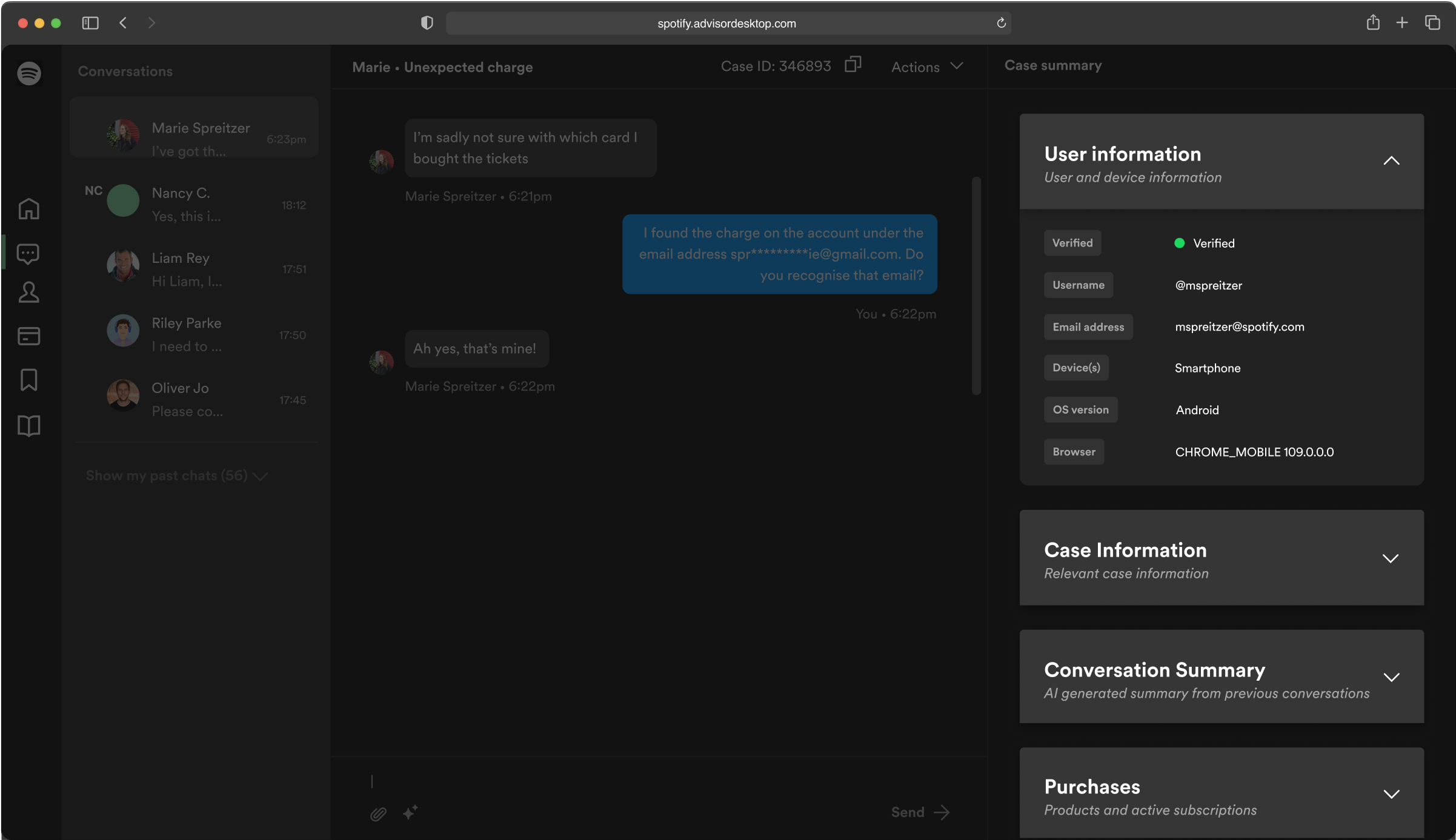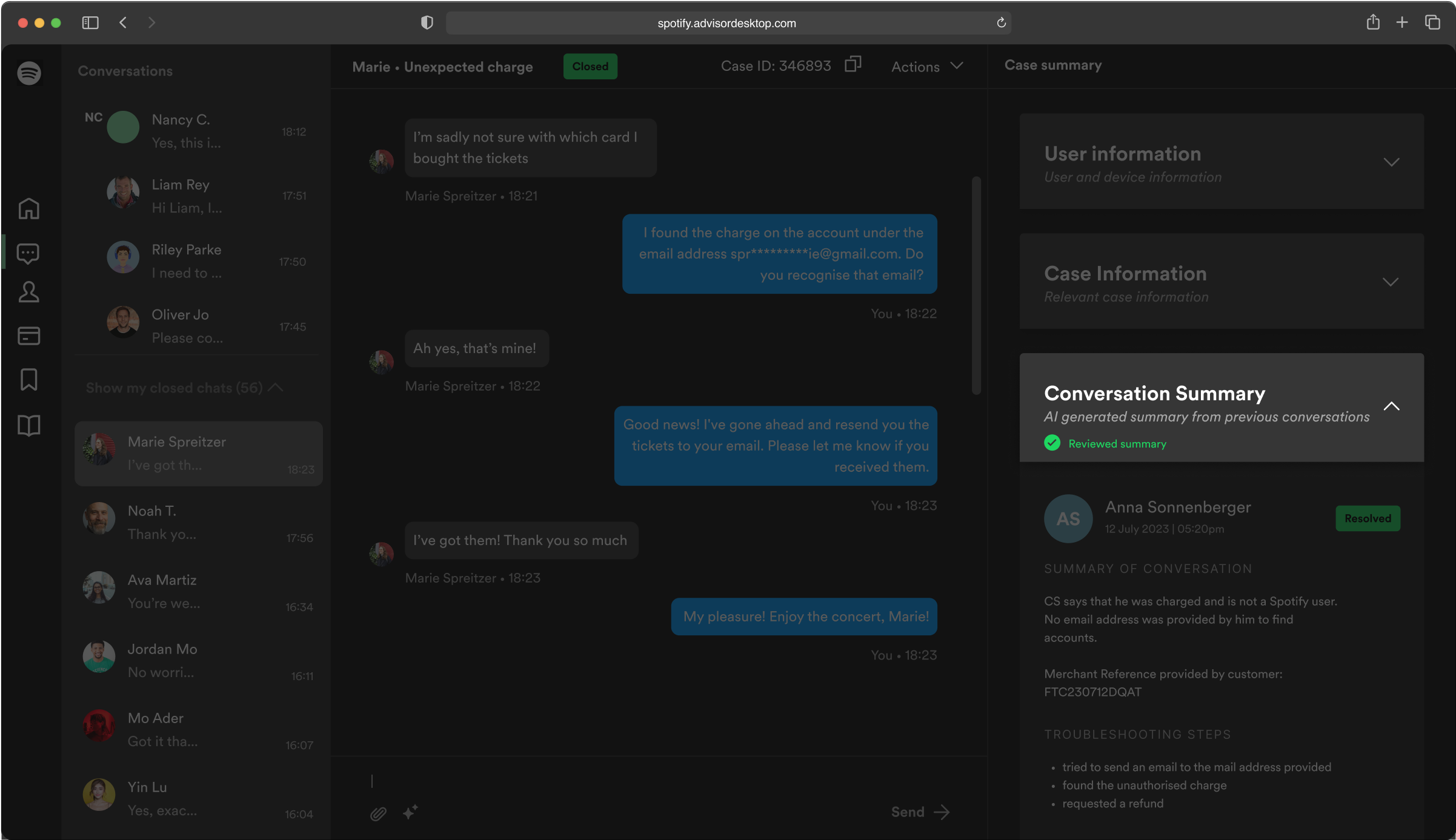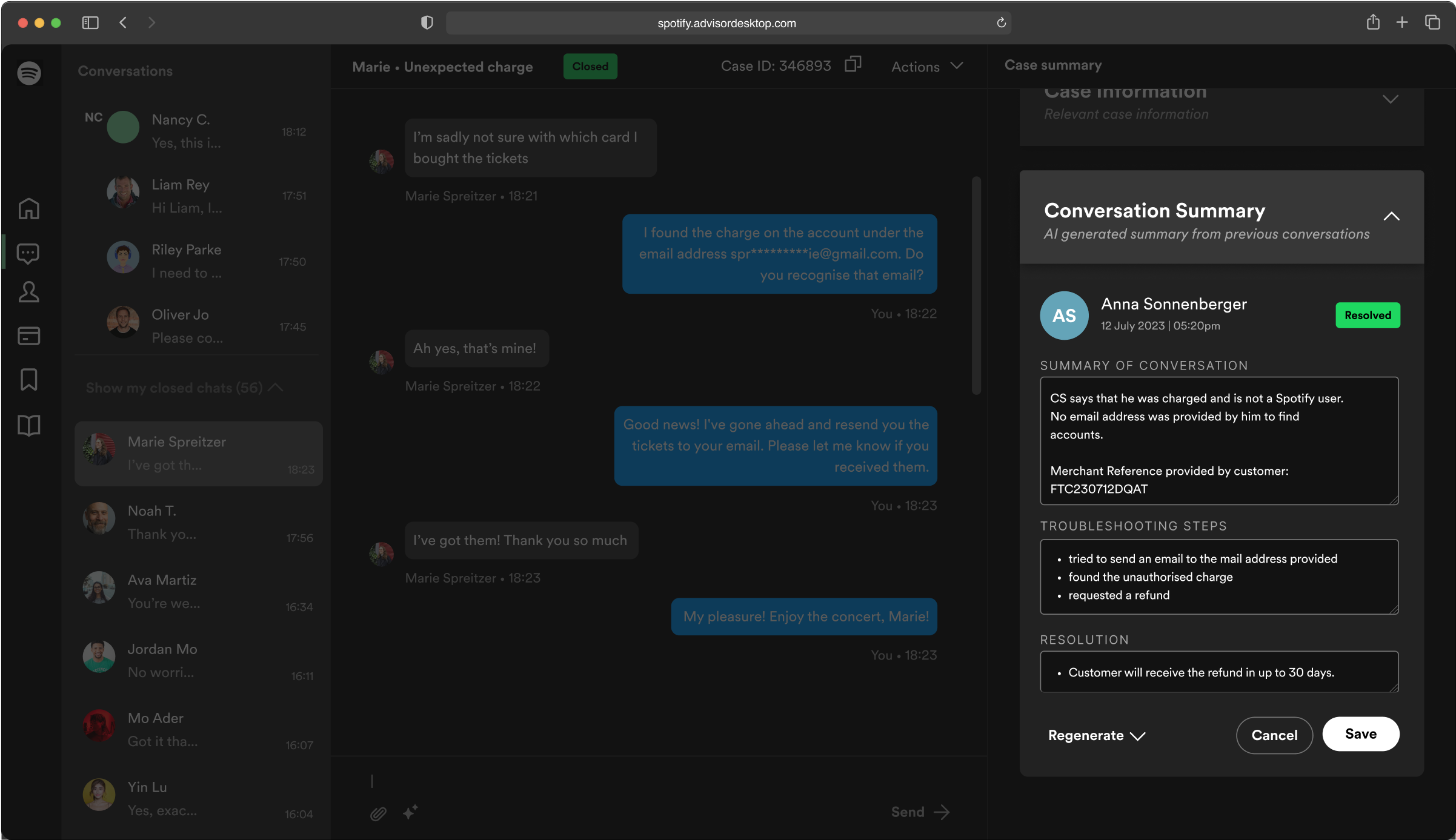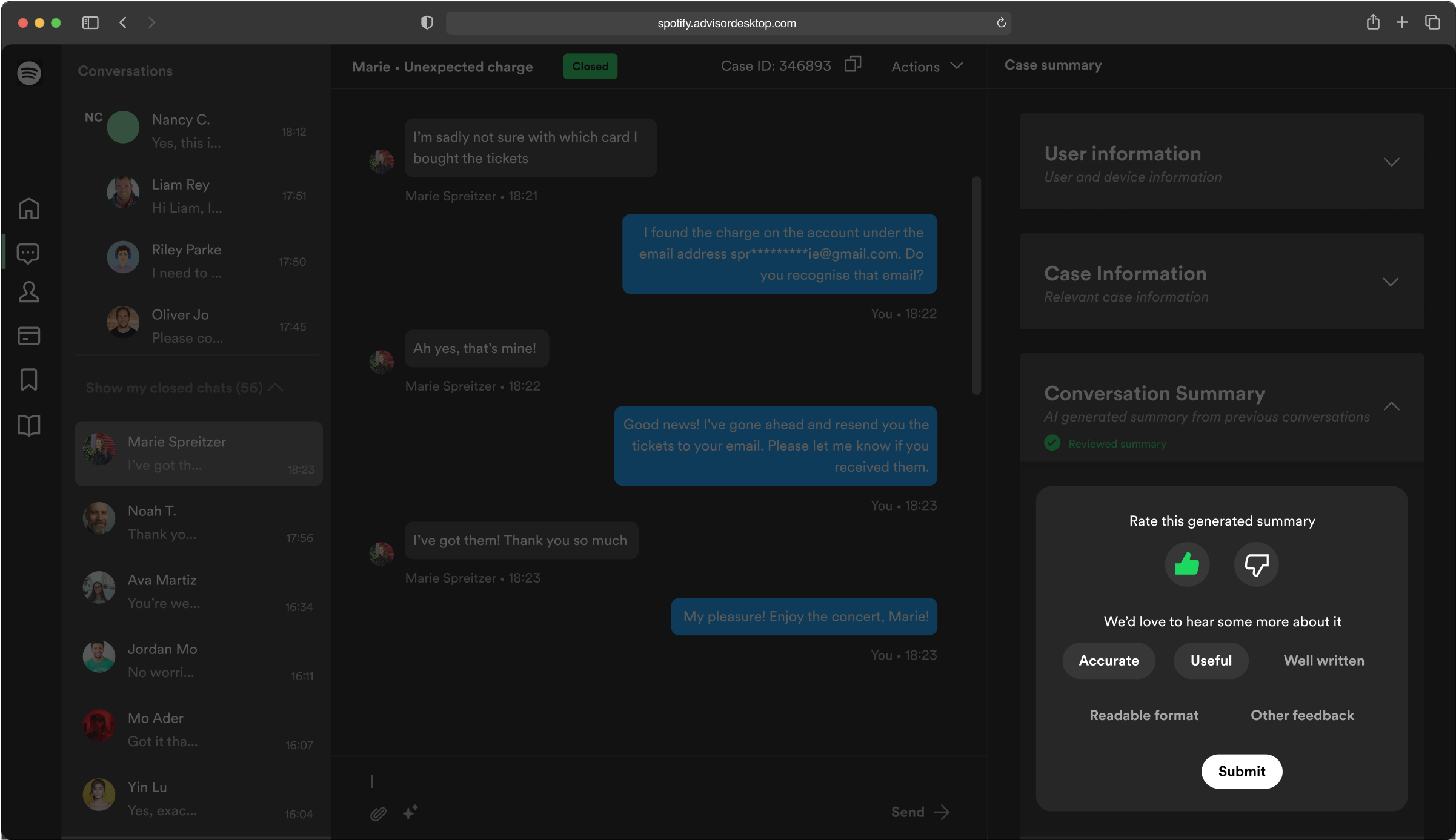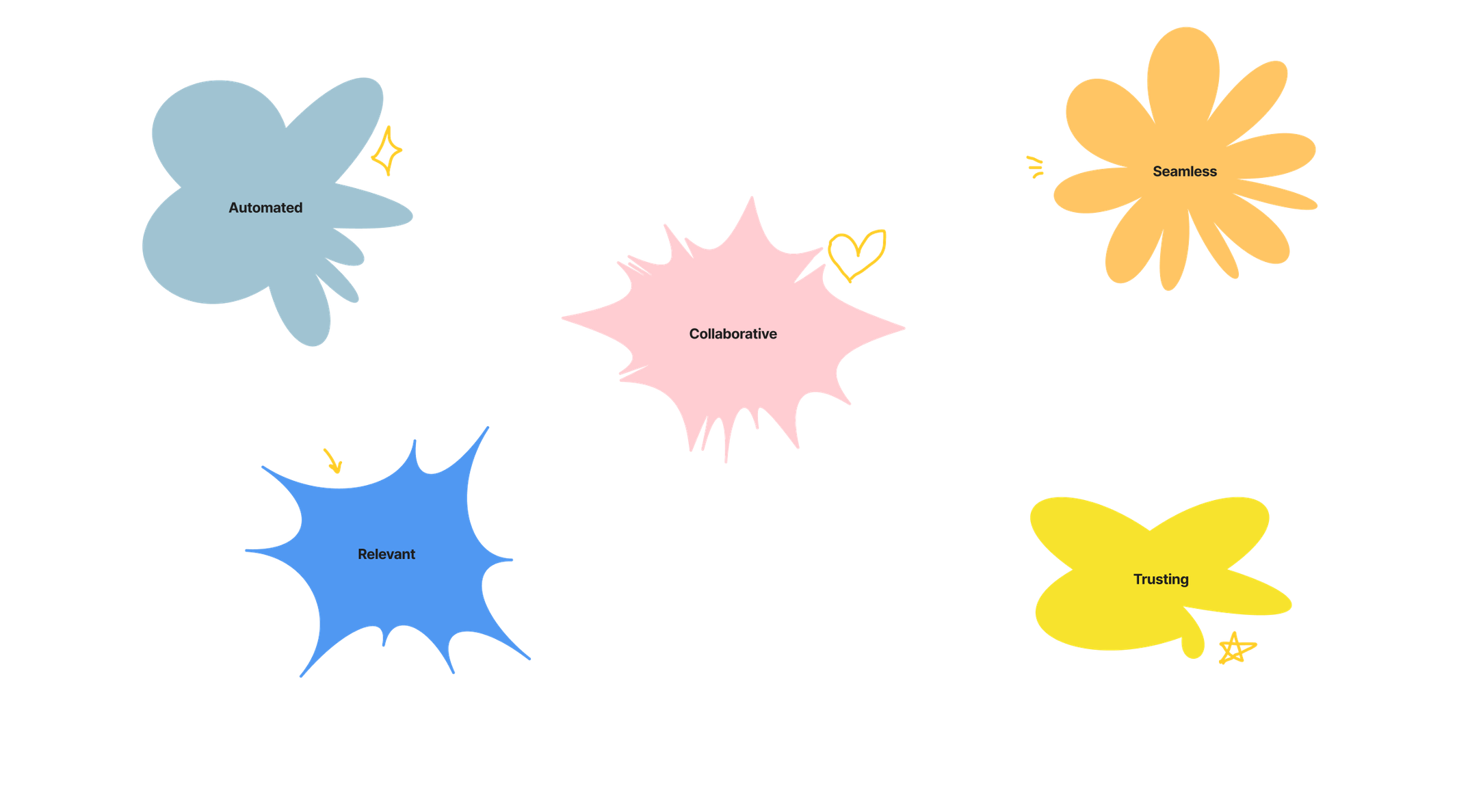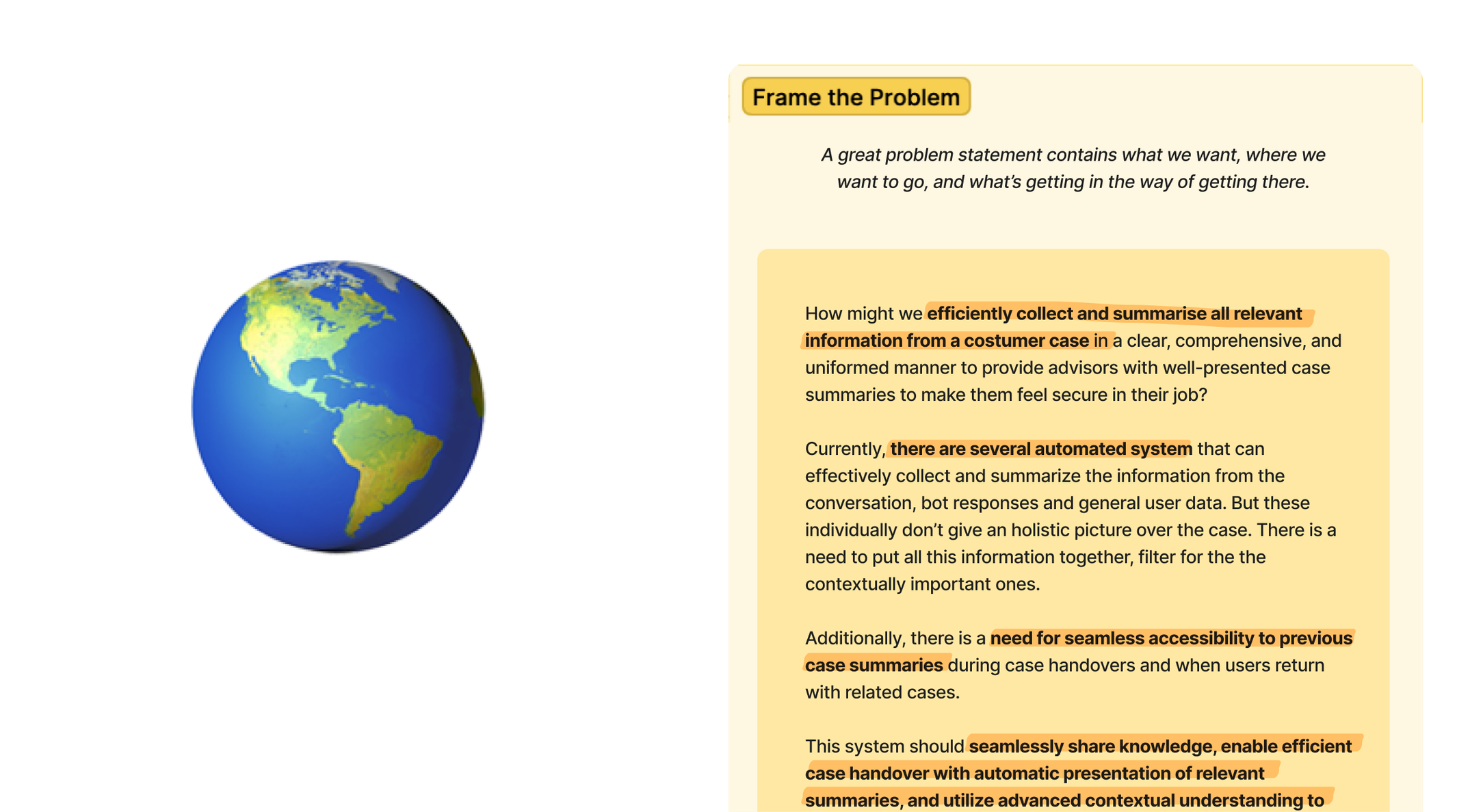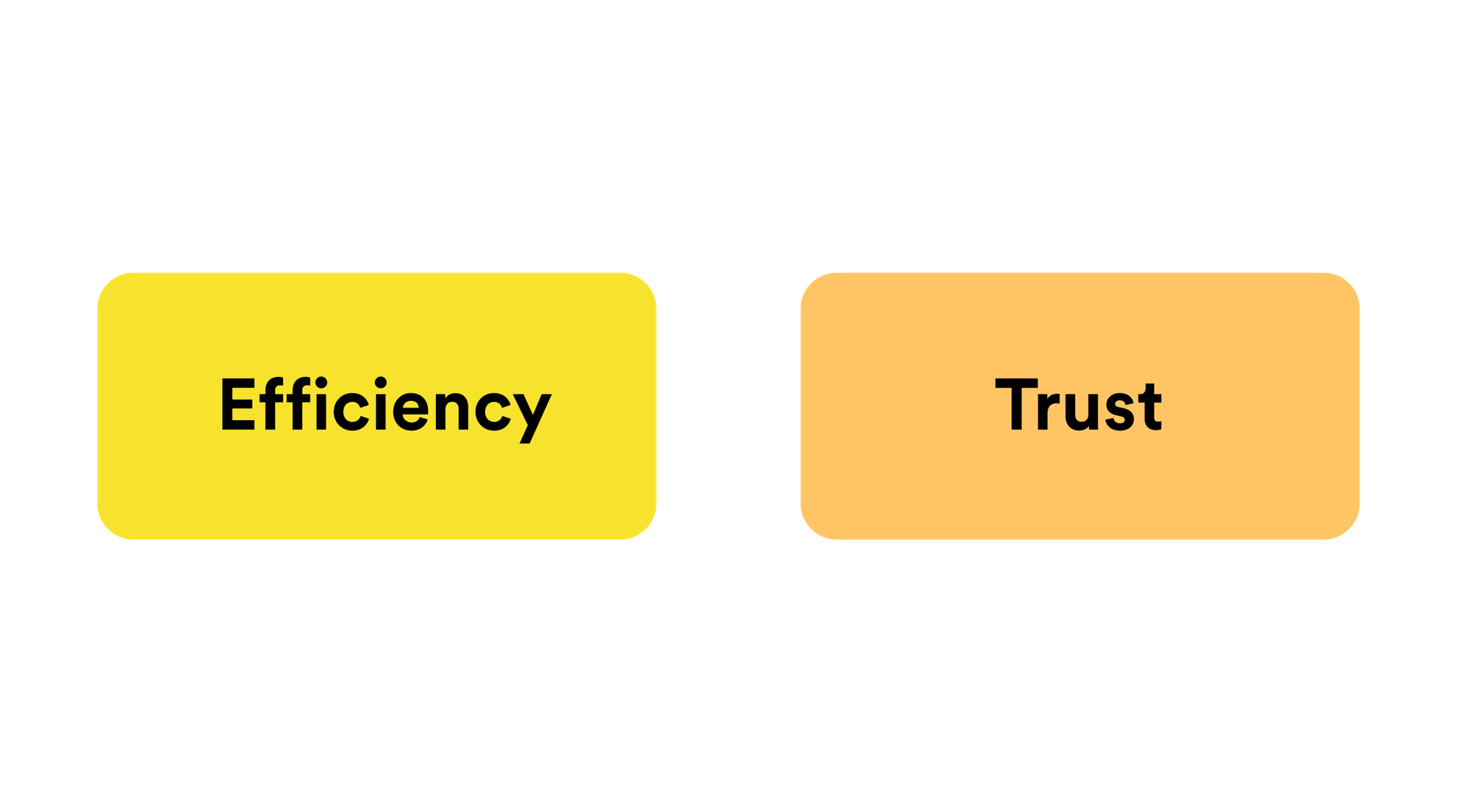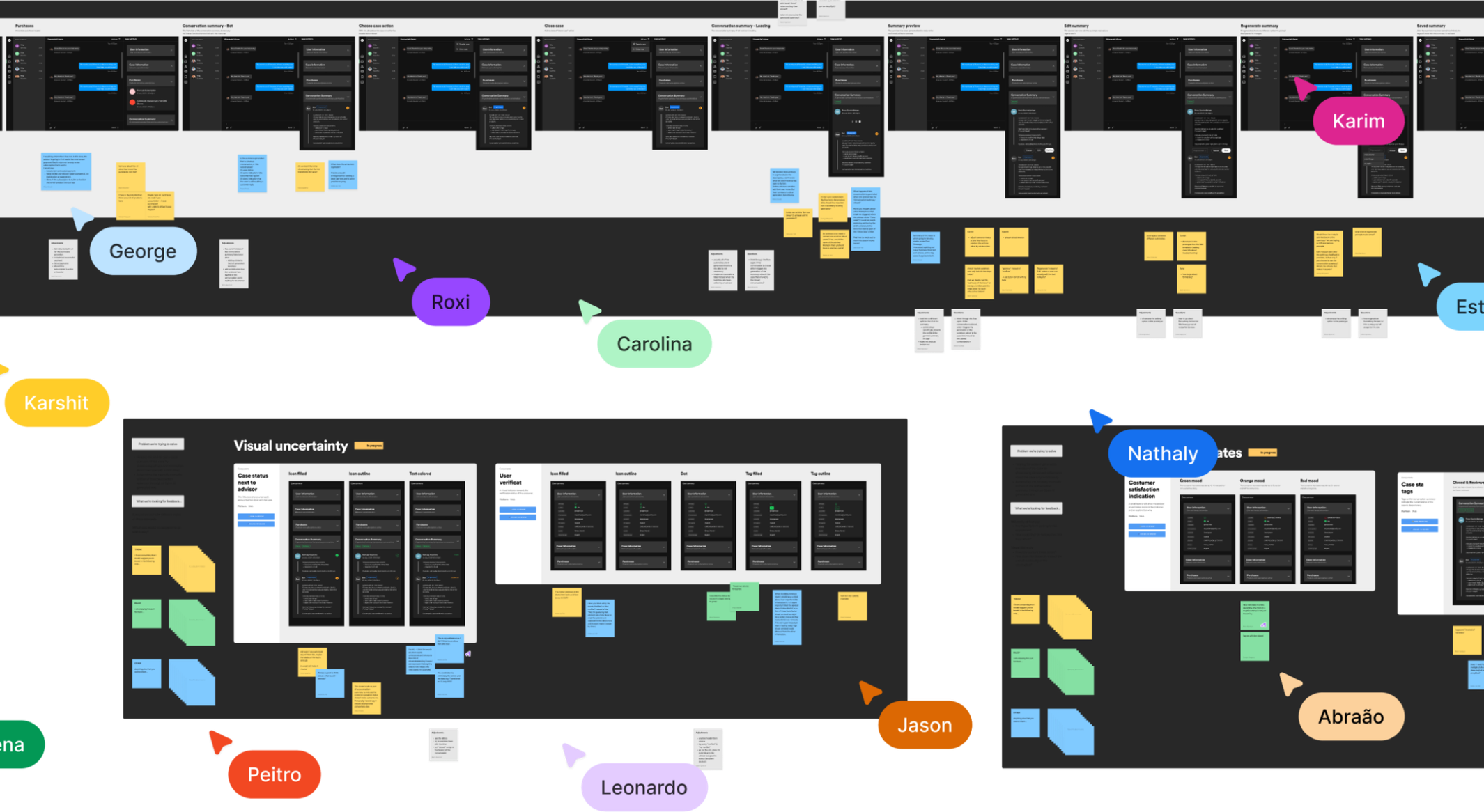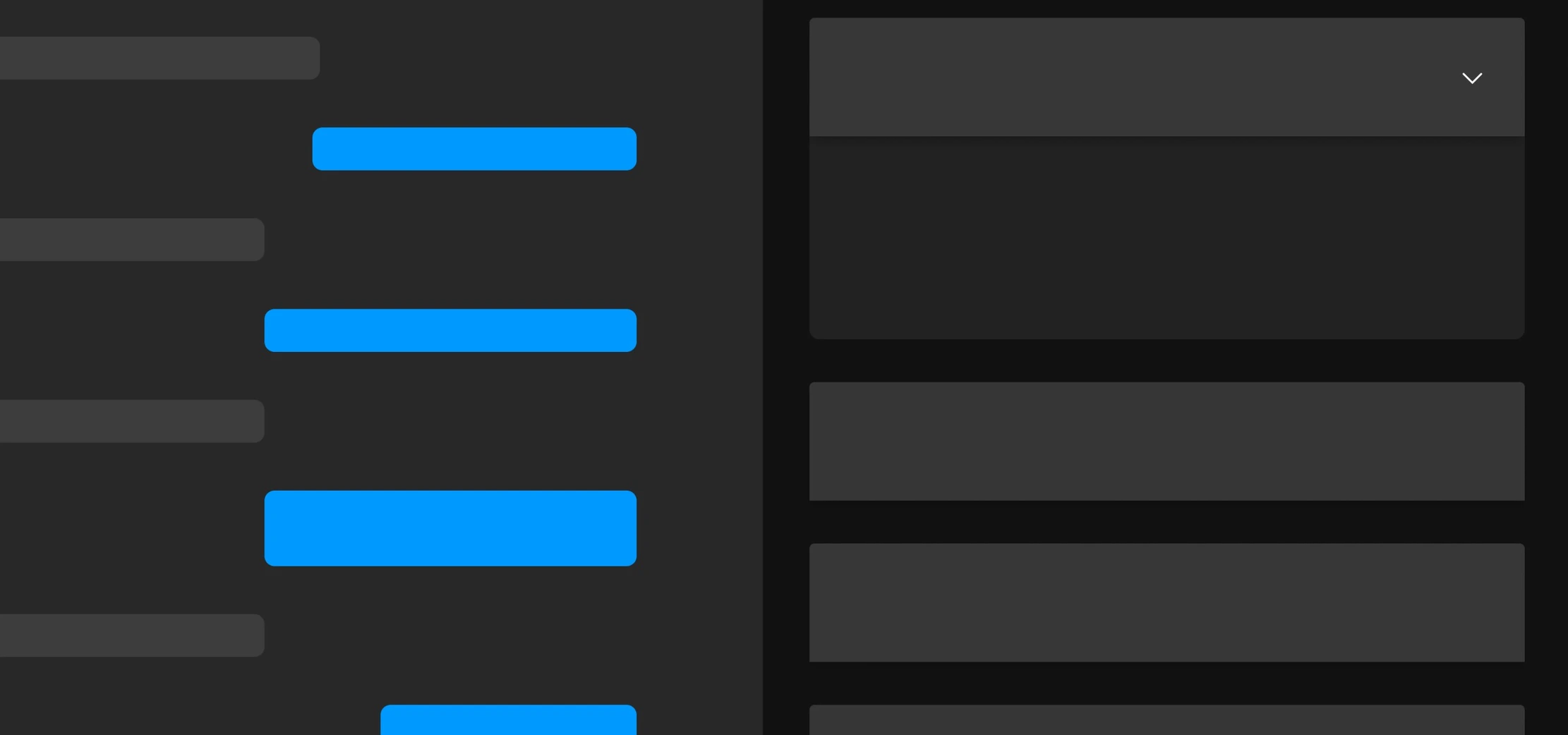

Goal
Create a widget that will document the conversation an advisor had with a customer more efficiently and design for a summary advisors can trust.
Context
Internship at Spotify
Summer 2023
Problem Space
Contacting customer support can be a hit or miss for users. Still, we need to consider what the advisors are going through. I aimed to address the advisor's side of the equation. At Spotify, 280,000 monthly users seek assistance via web chat. Their work necessitated using over 30+ tools, leading to cognitive overload. This led me to focus on the Case Summary within the Advisor Desktop – a tool meant to streamline and enhance the advisors' experience.
The Case Summary serves two purposes:
- Maintaining the quality of customer support documentation and facilitating seamless case transfers between advisors.
- Advisors manually create these summaries, taking an average of 50 seconds per case, accumulating to nearly 4,400 hours monthly.
Outcome
With an immense opportunity for improvement, I embarked on an in-depth exploration.
Two core values emerged: efficiency and trust.
Efficiency, optimizing time and resource utilization for advisors and users, and trust to ensure accurate and reliable information representation.
Guided by these values, my proposal centered on automating the summarization process using an OpenAI API, specifically ChatGPT. My solution aimed to optimize advisors' time while ensuring information accuracy, enhancing advisor productivity and user satisfaction. This proposal could cut the time advisor spends on the summary in half and save Spotify hella money each month.
Outcome
Next Steps
The team is diving into another round of iterations on the advisor desktop's overarching information architecture. While this will impact the specifics and positioning of the case summary, the core functions remain largely autonomous. User testing becomes vital to evaluate the concept. Gathering qualitative insights from users will be instrumental in measuring its efficiency.
In evaluating the user experience, several key UX metrics deserve close examination:
- Time Invested: Observing the time to generate or compose the summary will illuminate its practicality.
- Interaction Efficiency: Tracking the clicks required to produce or write the summary unveils its streamlined accessibility.
- Summary Comprehension: Evaluating users' time to comprehend the summary gauges clarity and conciseness.
- User Satisfaction: Capturing user feedback on their contentment with the summary ensures that it meets their expectations.
This data-driven approach, supported by these UX metrics, will provide a comprehensive view of the case summary's effectiveness, steering its refinement in the most user-centric direction.
A Moment of Reflection
I've really come to terms with how design can be challenging. Sticking rigidly to a set design process doesn't work out in the real world. Instead, I've found that embracing the messiness of uncertainty and challenges is where the magic happens. Trusting in my skills, even when things are a bit chaotic. It's like realizing that tackling complex issues is just as important as having all the answers. Designing for values has been a rock, guiding me when things get uncertain.
I also tackled my doubts head-on, especially regarding visual design. I used to hold back, unsure of my abilities. But working closely with my supportive colleagues showed me the power of teaming up. Getting help wasn't a weakness. It was about growing together. Their advice has been my secret weapon in navigating tricky visual design waters. And speaking of teamwork, chatting with colleagues from different areas has opened my eyes to new perspectives. Cross-discipline collaboration has enriched my understanding of projects in a big way. It's like realizing that teamwork isn't limited to just one department – everywhere.
Lastly, I learned to always stay critical. Questioning things is vital to solving problems for real. I made it a habit to reject quick fixes that only scratch the surface. I repeatedly asked the same questions, ensuring our efforts were geared toward real solutions. It's like sifting through the noise to find what really matters.


Goal
Create a widget that will document the conversation an advisor had with a customer more efficiently and design for a summary advisors can trust.
Context
Internship at Spotify
Summer 2023
Problem Space
Contacting customer support can be a hit or miss for users. Still, we need to consider what the advisors are going through. I aimed to address the advisor's side of the equation. At Spotify, 280,000 monthly users seek assistance via web chat. Their work necessitated using over 30+ tools, leading to cognitive overload. This led me to focus on the Case Summary within the Advisor Desktop – a tool meant to streamline and enhance the advisors' experience.
The Case Summary serves two purposes:
- Maintaining the quality of customer support documentation and facilitating seamless case transfers between advisors.
- Advisors manually create these summaries, taking an average of 50 seconds per case, accumulating to nearly 4,400 hours monthly.
Outcome
With an immense opportunity for improvement, I embarked on an in-depth exploration.
Two core values emerged: efficiency and trust.
Efficiency, optimizing time and resource utilization for advisors and users, and trust to ensure accurate and reliable information representation.
Guided by these values, my proposal centered on automating the summarization process using an OpenAI API, specifically ChatGPT. My solution aimed to optimize advisors' time while ensuring information accuracy, enhancing advisor productivity and user satisfaction. This proposal could cut the time advisor spends on the summary in half and save Spotify hella money each month.
Outcome
Next Steps
The team is diving into another round of iterations on the advisor desktop's overarching information architecture. While this will impact the specifics and positioning of the case summary, the core functions remain largely autonomous. User testing becomes vital to evaluate the concept. Gathering qualitative insights from users will be instrumental in measuring its efficiency.
In evaluating the user experience, several key UX metrics deserve close examination:
- Time Invested: Observing the time to generate or compose the summary will illuminate its practicality.
- Interaction Efficiency: Tracking the clicks required to produce or write the summary unveils its streamlined accessibility.
- Summary Comprehension: Evaluating users' time to comprehend the summary gauges clarity and conciseness.
- User Satisfaction: Capturing user feedback on their contentment with the summary ensures that it meets their expectations.
This data-driven approach, supported by these UX metrics, will provide a comprehensive view of the case summary's effectiveness, steering its refinement in the most user-centric direction.
A Moment of Reflection
I've really come to terms with how design can be challenging. Sticking rigidly to a set design process doesn't work out in the real world. Instead, I've found that embracing the messiness of uncertainty and challenges is where the magic happens. Trusting in my skills, even when things are a bit chaotic. It's like realizing that tackling complex issues is just as important as having all the answers. Designing for values has been a rock, guiding me when things get uncertain.
I also tackled my doubts head-on, especially regarding visual design. I used to hold back, unsure of my abilities. But working closely with my supportive colleagues showed me the power of teaming up. Getting help wasn't a weakness. It was about growing together. Their advice has been my secret weapon in navigating tricky visual design waters. And speaking of teamwork, chatting with colleagues from different areas has opened my eyes to new perspectives. Cross-discipline collaboration has enriched my understanding of projects in a big way. It's like realizing that teamwork isn't limited to just one department – everywhere.
Lastly, I learned to always stay critical. Questioning things is vital to solving problems for real. I made it a habit to reject quick fixes that only scratch the surface. I repeatedly asked the same questions, ensuring our efforts were geared toward real solutions. It's like sifting through the noise to find what really matters.


Goal
Create a widget that will document the conversation an advisor had with a customer more efficiently and design for a summary advisors can trust.
Context
Internship at Spotify
Summer 2023
Problem Space
Contacting customer support can be a hit or miss for users. Still, we need to consider what the advisors are going through. I aimed to address the advisor's side of the equation. At Spotify, 280,000 monthly users seek assistance via web chat. Their work necessitated using over 30+ tools, leading to cognitive overload. This led me to focus on the Case Summary within the Advisor Desktop – a tool meant to streamline and enhance the advisors' experience.
The Case Summary serves two purposes:
- Maintaining the quality of customer support documentation and facilitating seamless case transfers between advisors.
- Advisors manually create these summaries, taking an average of 50 seconds per case, accumulating to nearly 4,400 hours monthly.
Outcome
With an immense opportunity for improvement, I embarked on an in-depth exploration.
Two core values emerged: efficiency and trust.
Efficiency, optimizing time and resource utilization for advisors and users, and trust to ensure accurate and reliable information representation.
Guided by these values, my proposal centered on automating the summarization process using an OpenAI API, specifically ChatGPT. My solution aimed to optimize advisors' time while ensuring information accuracy, enhancing advisor productivity and user satisfaction. This proposal could cut the time advisor spends on the summary in half and save Spotify hella money each month.
Outcome
Next Steps
The team is diving into another round of iterations on the advisor desktop's overarching information architecture. While this will impact the specifics and positioning of the case summary, the core functions remain largely autonomous. User testing becomes vital to evaluate the concept. Gathering qualitative insights from users will be instrumental in measuring its efficiency.
In evaluating the user experience, several key UX metrics deserve close examination:
- Time Invested: Observing the time to generate or compose the summary will illuminate its practicality.
- Interaction Efficiency: Tracking the clicks required to produce or write the summary unveils its streamlined accessibility.
- Summary Comprehension: Evaluating users' time to comprehend the summary gauges clarity and conciseness.
- User Satisfaction: Capturing user feedback on their contentment with the summary ensures that it meets their expectations.
This data-driven approach, supported by these UX metrics, will provide a comprehensive view of the case summary's effectiveness, steering its refinement in the most user-centric direction.
A Moment of Reflection
I've really come to terms with how design can be challenging. Sticking rigidly to a set design process doesn't work out in the real world. Instead, I've found that embracing the messiness of uncertainty and challenges is where the magic happens. Trusting in my skills, even when things are a bit chaotic. It's like realizing that tackling complex issues is just as important as having all the answers. Designing for values has been a rock, guiding me when things get uncertain.
I also tackled my doubts head-on, especially regarding visual design. I used to hold back, unsure of my abilities. But working closely with my supportive colleagues showed me the power of teaming up. Getting help wasn't a weakness. It was about growing together. Their advice has been my secret weapon in navigating tricky visual design waters. And speaking of teamwork, chatting with colleagues from different areas has opened my eyes to new perspectives. Cross-discipline collaboration has enriched my understanding of projects in a big way. It's like realizing that teamwork isn't limited to just one department – everywhere.
Lastly, I learned to always stay critical. Questioning things is vital to solving problems for real. I made it a habit to reject quick fixes that only scratch the surface. I repeatedly asked the same questions, ensuring our efforts were geared toward real solutions. It's like sifting through the noise to find what really matters.
